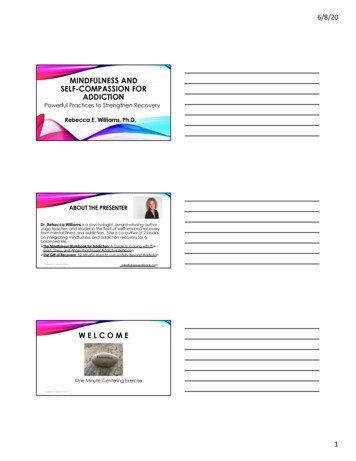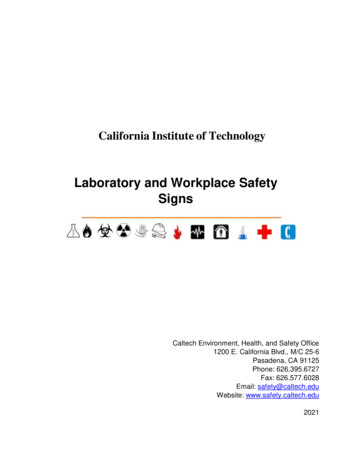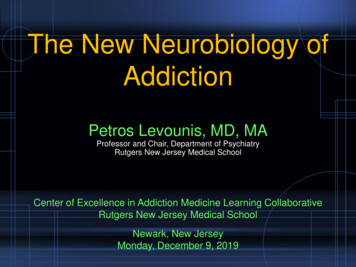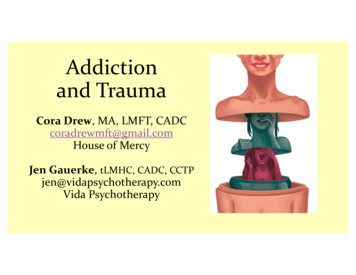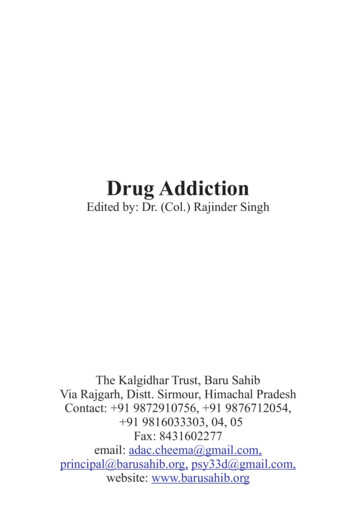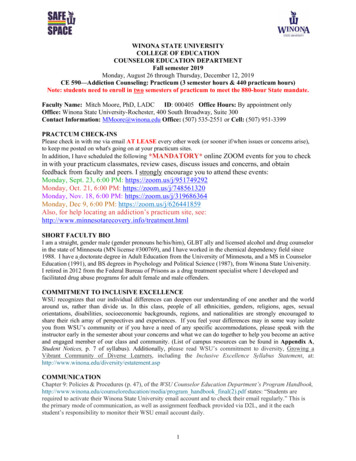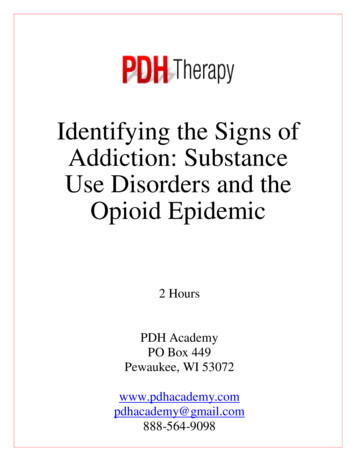
Transcription
Identifying the Signs ofAddiction: SubstanceUse Disorders and theOpioid Epidemic2 HoursPDH AcademyPO Box 449Pewaukee, WI -9098
Course Description:Health care practitioners often encounter patients with an illness with features that may also besymptoms of a substance use disorder. This course focuses on identifying the signs of substanceuse disorders with an emphasis on opioid abuse, a national epidemic, that has resulted in thenumber of overdose deaths involving opioids raising 6 times higher in 2017 than in 1999. Onaverage 130 Americans die every day from an opioid overdose. This course will include caseexamples and interactive exercises to reinforce learning. The course will also examine thehistory of drug and opioid epidemics, assessing substance abuse disorders, and an in-depthreview of the types of opioids.Course Objectives:After completing this course, learners will be able to: Identify the signs of substance use disorders with an emphasis on opioid use disorders inpatients Discuss the causes and impact of the present opioid epidemic Recognize the types of opioids and their effect on patients Identify screening and assessment tools to assist in identifying substance use disordersOutline1. Substance Use DisordersI.Medical and DSM 5 definition of addictiona. Addictionb.Dependencec. Use disorderII.Classification of substance use disordersc. Activity: Identify classification of disorder usage2. Review of classification of drugs and physical/behavioral signs of ensV.InhalantsVI.OpioidsVII.Sedatives, Hypnotics, and AnxiolyticsVIII.StimulantsIX.TobaccoX.Review questions3. Opioid EpidemicI.CausesII.Impacta. Communitiesb. Overdosesc. DeathsIII.Review questions4. Types of OpioidsI.Opioid Agonist1
II.III.IV.a. Opiumb. Morphinec. Codeined. Oxycodonee. Hydrocodonef. Propoxypheneg. Meperidineh. Diacetylmorphinei. Hydromorphonej. Methyl fentanylk. MethadoneOpioid Partial Agonista. Buprenorphineb. PentazocineOpioid Antagonista. Naloxoneb. NaltrexoneReview questionsSummary2
Final Exam1. There are as many as risk factors for substance use and dependence.a. 85b. 10c. 18d. 722. A 16-year-old female presents for a schedule appointment with her pediatrician. When she signed forher appointment the receptionist noticed the patient had a flushed face with some muscle twitchingand seemed unusually nervous. These observations would lead to believe the patient is sufferingfrom:a.Alcohol intoxicationb.Caffeine intoxicationc.Caffeine withdrawald.Stimulant intoxication3. Two to three milligrams of fentanyl can induce respiratory depression, arrest and possibly death. Twoto three milligrams of fentanyl are about the same as toindividual grainsof table salt.a. 3 to 4b. 6 to 8c. 5 to 7d. 10 to 154. is a fentanyl analogue that has been estimated to be 10,000 times stronger than morphine.a. Acetylfentanylb. Furanylfentanylc. Carfentanild. Oxycodone5. Naloxone is primarily used to reverse the effects of opioid overdose.a. hypertensionb. hallucinogenicc. severe mood disordersd. pulmonary6. Which of the following substances is a Schedule I drug under the Controlled Substance Act (CSA)?a. marijuana.b. fentanyl.c. cocaine.d. pentobarbital.3
7. Under the Diagnostic and Statistical Manual of Mental Disorders,Fifth Edition (DSM-5), the inappropriate use of drugs is termeda. drug dependence.b. illicit drug disorder.c. substance use disorder.d. addiction.8. When heroin enters the brain, enzymes convert it to and binds rapidly to opioidreceptors.a. narcanb. dopaminec. heroin acetated. morphine9. Marijuana users are a. three times as likely to abuse heroin.a. three times as likelyb. less likelyc. twice as likelyd. not likely10. The likelihood that drug use will lead to addiction depends on the with which it promotesdopamine release in the brain, the of that release, and the of that release.a. speed, intensity, reliabilityb. intensity, speed, reliabilityc. efficiency, speed, reliabilityd. reliability, speed, intensity11. Heroin use more than doubled among , during the past decade.a. young adults, aged 18-25 yearsb. teens 14-17 years oldc. individuals over 40d. adults, aged 25-35 years12. In 2008, drug overdoses, mostly from opiates, surpassed auto fatalities as leading cause of accidentaldeath in the United States.a. Trueb. False13. Nearly percent of all drug-related emergency department visits in 2011 involvedthe use of meth.a. 3%b. 8.2%c. 6.5%d. None of the above4
14. In over 40 states, opioid overdoses increased about percent from July 2016 throughSeptember 2017.a. 30b. 40c. 50d. 6015. What are some treatment options for heroin and other opioid addictions?a. Medication Assisted Detoxb. Medication Assisted Maintenancec. Psychosocial Interventionsd. All of the above5
Identifying the Signs of Addiction: Substance Use Disorders and the OpioidEpidemicEarl Ledford, MSW, LCSW, CST, CAP, CETRene’ Ledford, MSW, LCSW, BCBAAddiction is nota spectatorsport.Eventually, thewhole familygets to play.There was a time in the history of addictions it was believed that a personwas addicted to a drug only if they needed the drug daily, or if they wentthrough withdrawal symptoms (vomiting, seizures, cramps, death) whenhe/she abruptly stopped using the substance. There was a stigma thatalcoholics and addicts were unemployed, poor, and from the inner city.Those are misconceptions. We now know that all substances do notpose the same risks and many addicted people do not use drugs oralcohol daily and do not experience physical withdrawal when theystop using and are employed and appear to be functioning normally.Another misconception dealt with the differences between physical and psychological addiction.Physical addiction was thought to be the determining factor in addiction, and little was paid topsychological addiction. For example, many people believed that cocaine was not a dangerousdrug because it was psychologically, but not physically, addictive.The cocaine epidemic, between 1984 and 1990, in this country broadened the understanding ofaddiction. It is now known that physical and psychological changes characterize all addictions.Addiction is far more than physical or psychological dependency. Drug addiction is a braindisease that is characterized by compulsive, at times uncontrollable, drug craving, seeking, andcontinued use that persists even in the face of extremely negative consequences. Drug seekingbecomes compulsive, in large part because of the effects of prolonged drug use on brainfunctioning and behavior. For many people, drug addiction becomes chronic, with relapsespossible even after long periods of abstinence.Addiction, Dependence and Substance Use DisorderThe terms used to describe or define problems people have with illegal, illicit, and prescribeddrugs can be confusing. The terms addiction and dependence are used interchangeably withaddiction being the term most commonly used by healthcare and mental health professionals aswell as in the general population. According to Michael Quinn, in the sixteenth century, theword addict was an adjective, not a noun, and was used to identify an attachment to something ora devotion to practice. Early in the twentieth century, it became a practice to use addict as anoun to describe a person whose preference for a substance that led to dependence. The nounaddiction became the condition of being addicted to a substance. (Addiction, n.d.).The American Society of Addiction Medicine’s short definition of addiction, “Addiction is aprimary, chronic disease of brain reward, motivation, memory and related circuitry. Dysfunctionin these circuits leads to characteristic biological, psychological, social and spiritual6
manifestations. This dysfunction is reflected in an individual pathologically pursuing reward andrelief by substance use and other behaviors.Addiction is characterized by inability to consistently abstain, impairment in behavioral control,craving, diminished recognition of significant problems with one's behaviors and interpersonalrelationships, and dysfunctional emotional response. Like other chronic diseases, addiction ofteninvolves cycles of relapse and remission. Without treatment or engagement in recovery activities,addiction is progressive and can result in disability or premature death." (American Society ofAddiction Medicine, n.d.).The National Institute of Drug Abuse’s definition of dependence is, “a state in which organismfunctions normally only in the presence of a drug; manifested as physical disturbance when thedrug is removed (withdrawal).” (National Institute on Drug Abuse. (n.d.). Physical dependencecan become an issue with the regular use of many drugs including many prescription drugs, evenwhen taken as prescribed. According to the American Psychiatric Association dependenceresulting from taking prescription drugs as directed is a medical problem, not a mental healthissue. (American Psychiatric Association’s DSM5, 2013)There are as many as 72 risk factors for substance use and dependence (Leshner, 1998).Included in these 72 risk factors are poverty, racism, social dysfunction, dysfunctional families,lack of education, poor parenting, and high-risk peer groups. Risk, environmental and geneticfactors influence one's initial decision to use substances of abuse. Continued use of a substancebecause the effects are likable: mood is elevated, perception of situations appears more positiveto user and emotional state seems to be improved. Someone who has an addiction is not able tostop using a drug even though there is a failure to meet work, social, or family obligations.Tolerance and withdrawal can result from continued long-term use. Withdrawal results whenthere is physical dependence, and the body and brain require more of the substance to reach thesame level of effect (tolerance) and resulting drug-specific physical or mental symptoms if druguse is abruptly stopped (withdrawal). Prescribed pain medications taken as instructed might alsoresult in the need for increasing dosages(tolerance).Scenario One. During the last year, your co-worker's doctor has prescribed her benzodiazepine,Klonopin, to be taken every night for sleep. She has started to show signs of being anxious aboutneeding the medication to fall asleep. She complains of being helpless to stop taking the drug byherself. After talking to her doctor, they were able to gradually taper off the drug and start usinga sleep aid that was less harmful.Scenario Two. One of your teammates on the company softball team has been taking Oxycontinto manage the pain in one of his shoulders and has been using higher doses, even though he hastried several times to cut down. He can’t play softball unless he takes Oxycontin. His workperformance has been declining, he’s missing work, and avoiding you and other co-workers.Lately, he has missed more and more practices and continues to take the drug while his work andsocial life are suffering.In which of these scenarios is addiction the problem?7
If you picked scenario two, you are correct. The difference between addiction and dependence iscompulsive drug use that continues despite the negative consequences.The American Psychiatric Association (APA) does not use the terms addiction, dependence ordrug abuse. The APA’s Diagnostic and Statistical Manual of Mental Disorders Fifth Edition(DSM–5), published May 18, 2013, Substance-Related and Addictive Disorders Sectionclassifies substance use disorders by severity depending the number of criteria met. Table 1,Substance Use Disorder Severity Ratings, summarizes that criteria.Table 1 – Adapted from American Psychiatric Association’s DSM 5The substance-related disorders encompass ten separate classes of drugs: alcohol; caffeine;cannabis; hallucinogens; inhalants; opioids; sedatives, hypnotics, and anxiolytics; stimulants(amphetamine-type substances, cocaine, and other stimulants); tobacco; and other (or unknown)substances. The defining feature of a substance use disorder is a group of cognitive, behavioral,and physiological symptoms that result when the individual continues using despitesignificant substance-related problems. The diagnosis of a substance use disorder applies to allten classes except caffeine. As with dependence and addiction, the nature of substance usedisorders is a change in brain circuits, particularly in individuals with severe disorders. Thesebrain changes may result in repeated relapses and intense drug craving especially when exposedto similar or familiar drug use situations or environments.Using Scenario Two from above, rate the severity of your teammate's use of Oxycontin. One ofyour teammates on the company softball team has been taking Oxycontin to manage the pain inone of his shoulders and has been using higher doses, even though he has tried several times to8
cut down. He can't play softball unless he takes Oxycontin. His work performance has beendeclining, he's missing work, and avoiding you and other co-workers. Lately, he has missed moreand more practices and continues to take the drug even though his work and social life aresuffering. Using Table 1 rate the severity of your teammates substance uses disorder.MildModerateSevereIf you rated his substance use disorder as severe, you are correct. Your teammate use ofOxycontin is severe because he:1. is taking the substance in higher doses.2. has tried several times to cut down.3. fails to meet major role obligations.4. continues to use despite recurring social and interpersonal problems.5. is giving up important social and recreational activities, and6. continues to use despite problems of use.Each of the ten substance categories identified by the American Psychiatric Association (APA)has specific coding criteria listed in the APA’s DSM 5 that are used by mental health andpsychiatric professionals.Specific Drug Use Disorder Specific Drug Intoxication Specific Drug Withdrawal, except for Hallucinogens and Inhalant Disorder.Cannabis and Caffeine withdrawal is new Other Specific Drug-Induced Disorders Unspecified Specific Drug-Related Disorder This course will address the specific drug use disorder, specific drug intoxication, and specificdrug withdrawal. Drug intoxication and drug addiction are not the same. The criteria forintoxication may be observed during an office visit while addiction or severity of a substance usedisorder has to be assessed over a period of time using the criteria in table 1.The International Statistical Classification of Diseases and Related Health Problems (ICD), amedical classification list by the World Health Organization (WHO) contains specific codingcriteria for health care professionals for both diagnoses and procedures. The United States usesthe 10th revision, ICD-10-CM. ICD-10-CM codes are also included in APA’s Diagnostic andStatistical Manual of Mental Disorders Fifth Edition (DSM–5), published May 18, 2013. Thiscourse does not address the specific medical and mental health coding practices and procedures.9
The coding criteria related to substance use disorders in the ICD-10-CM has a primary part of thecode that first identifies Mental and Behavioral Disorders due to the substance involved. Afterthe substance involved has been coded a specifier is added for (1) abuse and (2) dependence.Each specifier is further coded with 17 different extensions starting at uncomplicated and withintoxication (uncomplicate, delirium, with perceptual disturbance, or unspecified) followed bythree additional specifiers with each having specifiers. An example is F10.121 is the code forAlcohol abuse with intoxication delirium coding with the ICD-10-CM. A similar code using theDSM 5 for a moderate or severe alcohol use disorder is comorbid, the ICD-10-CM code isF10.229. DSM 5 coding is limited to a coding under mild substance use disorder ormoderate/severe substance abuse disorder.“A copy of the ICD-10-CM can be downloaded by visiting the Centers for Disease Control andPrevention website, https://www.cdc.gov/nchs/icd/icd10cm.htm, and go to "FY 2016 release ofICD-10-CM" section. Select ICD-10-CM PDF format to access a PDF version of the document.It directs you to an index of compressed zip files. Within that index, selectICD10CM FY2016 Full PDF.ZIP. This zip folder contains five files. Open the final file labeled'Tabular.' “(Practice Research. (n.d.). Substance use disorders and ICD-10-CM coding.Retrieved April 08, 2018, from /substance-disorders.aspx)Effects of Drug Use on the BrainMost addictive drugs affect the brain's reward center by flooding it with the neurotransmitterDopamine. The reward center controls a person's ability to feel pleasure and motivates a personto repeat behaviors needed to thrive, such as eating and spending time with loved ones. Theoverstimulation of the reward center that occurs when drugs are taken causes an intenselypleasurable high that can lead people to desire the drug/addictive substance.As a person continues to use drugs, the brain adjusts to the excess dopamine by making less of it,reducing the ability of cells in the reward center to respond to it, and reducing the number ofreceptor cells. The lack of response to dopamine reduces the high the person now feels comparedto the initial high they felt when the drug was first taken- this effect is known as tolerance.Individuals may begin to consume more of the drug in attempts to achieve the initial high. Theincrease in tolerance can also lead individuals to get less pleasure from other activities theypreviously enjoyed such as family and social functions.Long-term alcohol/drug causes other changes in the brain’s chemical systems and circuitsaffecting functions that include:Learning Judgment Decision-Making Stress Memory Behavior 10
Genetic Component of AddictionThere is not a stand-alone risk factor that can predict if a person will become addicted to drugs.The more risk factors are affecting an individual, the more likely it is the chance that consumingdrugs/alcohol can lead to addiction. Some of the more common risk factors are:Genetics: the genes that people are born with account for about half a person's risk ofdeveloping a substance abuse disorder. Also, the presence of other mental health disorders caninfluence the risk of drug use and addiction.Environment: the environments that people live, work, and play in can have many differentinfluences and risk factors. Family and friends to socioeconomic status and general quality oflife, peer pressure, history of physical and sexual abuse, early exposure to drugs, stress, andparental guidance can affect a person's likelihood of using drugs and alcohol to cope.Development: the genetic and environmental factors discussed above interact with thedevelopment stages in a person's life to affect addiction risk. Using alcohol/drugs at any age canlead to addiction, however, the earlier the addictive patterns begin, the more likely it willprogress to a substance use disorder. A neurologic locus within the frontal cortex is associatedwith deferring gratification. In adolescence and young adulthood that locus is not fully mature,making early exposure to substance use more likely to develop into addiction.(Source: National Institute on Drug Abuse; National Institutes of Health; U.S. Department ofHealth and Human Services.)Addiction and the BrainThe human brain registers all pleasures the same way regardless of how they originate, from apsychoactive drug, a monetary reward, a sexual encounter, or a satisfying meal. In the brain,pleasure releases the neurotransmitter dopamine. All drugs of abuse from nicotine to heroin andcocaine cause a powerful release of dopamine in the brain. The likelihood that drug use will leadto addiction depends on the speed with which it promotes dopamine release in the brain, theintensity of that release, and the reliability of that release. The more the "pleasure response" inthe brain, the higher that person is at risk for developing a substance use disorder. The way adrug is consumed also influences how likely it is to lead to addiction. Smoking a drug orinjecting it (IV use) compared to orally taking the drug, generally produces a faster, strongerdopamine release in the brain and is more likely to lead to a substance use disorder.Brain’s Reward CenterAddictive substances provide a shortcut to the brains reward system by flooding it with theneurotransmitter dopamine. The brain then creates memories of the rapid sense of satisfactionthat drugs create, and it creates a conditioned response to certain stimuli (related to drug use),and a person begins to crave the addictive substance. According to the current theory ofaddiction, dopamine interacts with another neurotransmitter, glutamate to take over the brain'ssystem of reward-related learning. This reward-related learning system has an important role inlinking activities needed for survival with pleasure and reward. The reward center in the brainincludes areas involved with motivation, memory, and pleasure. Addictive substances stimulate11
the reward center and overload it. Repeated use of addictive substance or engagement inaddictive behavior causes nerve cells to be modified from liking the substance or behavior to theuser needing the substance or behavior.ToleranceOver time the brain adapts to the abused addictive substance in a way that the drug becomes lesspleasurable and begins to require higher amounts be consumed to experience the initial levels ofpleasure. Rewards typically come with time and effort, however addictive substances provide ashortcut, and produce 2-10 times the amounts of dopamine that natural rewards do, and they do itsignificantly faster. When a person becomes addicted, brain receptors for dopamine becomeoverwhelmed (due to the flooding of dopamine). When the receptors are overwhelmed theyproduce less dopamine, and some dopamine receptors are destroyed. As a result, dopamine hasless of an impact on the brain's reward center. Individuals using addictive substances in timebegin to realize the desired substance no longer gives them as much pleasure. They must takemore of it to obtain the same dopamine "high" because their brains have adapted. This conceptis known as tolerance.After tolerance builds up, compulsions take over. The pleasure associated with an addictive drugor behavior subsides and the memory of the desired effect and the need to recreate it (the wantfor the drug) persists. The learning process discussed previously also plays an important role.The memories of initial drug use help create a conditioned response and intense cravings arise. Aperson begins to crave the abused drug. Cravings not only contribute to addiction cravings theyalso contribute to relapse. A person is at risk for relapse even after years of sobriety due toconditioned learning.DependenceWhen drugs are used in a manner or amount inconsistent with the medical or social patterns ofculture, it is considered drug abuse. In addition to having abuse potential, most controlledsubstances, and illicit drugs can produce physical and psychological dependence. Let's explorethe difference between the physical and psychological dependence.Physical DependencePhysical dependence refers to the changes that occur in the body after repeated use of a drug thatrequires the continued administration of the drug to prevent withdrawal symptoms. Withdrawalsymptoms can range from mildly unpleasant to life-threatening. The severity of the symptomsdepends on the drug used, the amount and how used, the combination of other drugs used, thefrequency and how long used, and the age, sex, health, and genetic makeup of the user.Psychological DependencePsychological dependence refers to the perceived need or craving for a drug. Individuals who arepsychologically dependent on a drug often feel that they cannot function without the continueduse of that substance. Physical dependence can disappear within days or weeks after drug usestops. Psychological dependence can last much longer and is one of the primary reasons forrelapse.12
Consequences of AddictionIndividuals who are addicted to a substance, typically do not stop using drugs until they havesuffered enough negative consequences, and most importantly until they are ready to change.The most significant consequences of addiction are social, emotional, and psychological.Individuals in active addiction usually think of the physical and economic implications ofaddiction: "I don't have a serious addiction because my health is fine, and I haven't lost my job."What individuals fail to understand is that health decline and functional impairment are usuallyconsequences of late- stage addiction. The damage that addiction does to a person's self-esteemand relationships is far more profound than the damage done in other critical areas offunctioning. Individuals with active addiction hurt family members, friends, and other importantpeople in their lives. ((Source: National Institute on Drug Abuse; National Institutes of Health;U.S. Department of Health and Human Services.)Drug intoxication and drug addiction are not the same. This course presents drug intoxicationsigns and symptoms for each of the drug categories that may be observed during a person’s visitto your office or organization. In order to assess the possibility of a mild, moderate, or severedrug use disorder (or addiction) the behaviors and conditions illustrated in Table 1 must bedetermined through a more in-depth information gathering. A person meeting any of theconditions presented in this course during an office visit should be referred for continuedscreening and assessment by a professional specializing in substance use disorders (addictions)treatment.Substance Use Disorders, Identification, and Signs of Severe Use DisorderAlcohol Use DisorderThe Journal ofAmerican MedicalAssociation (JAMA)Psychiatry found from2002 to 2013 problemsdrinking with alcoholincreased by nearly 50percent. Amongwomen, alcohol abuseand dependenceincreased by 83.7percent. Among blackpeople, it increased by92.8 percent. Amongthe poor (earning lessthan 20,000) it roseby 65.9 percent.Under the shadow of the current opioid addiction crisis in theUnited States (42,000 deaths in 2016), alcohol abuse is quietly onthe rise (CDC reports there are 88,000 deaths a year). A new studypublished in JAMA Psychiatry reported occurrences of AlcoholUse Disorder (AUD) rose by 49 percent between 2000 and 2010.The report indicated one in eight American adults (12.7 percent) inthe United States currently meets the criteria for AUD. Theincrease is even higher for women, minorities, and older agegroups.Excessive alcohol use increases the risk of developing serioushealth problems. The 2015-2020 U.S. Dietary Guidelines forAmericans defines moderate drinking to be up to 1 drink per dayfor women and up to 2 drinks per day for men. The NationalInstitute on Alcohol Abuse and Alcoholism (NIAAA) definesbinge drinking as a pattern of drinking that produces blood alcoholconcentrations (BAC) of greater than 0.08 g/dL. BAC of greaterthan 0.08 g/dL usually occurs after four drinks for women and five13
drinks for men over a 2-hour period. Substance Abuse and Mental Health ServicesAdministration (SAMHSA) defines binge drinking as consuming 5 or more drinks on the sameoccasion on at least one day in the past 30 days and heavy drinking as consuming 5 or moredrinks on the same occasion on each of 5 or more days in the past 30 days.Excessive drinking can put an individual at risk of developing an alcohol use disorder in additionto other health and safety problems. Genetics has also been shown to be a risk factor for thedevelopment of an AUD.Signs of alcohol intoxicationBreath that smells like alcohol Blackouts or seizures Enlarged pupils Eye movements that are faster than normal for you Fast heartbeats and slow breaths Loss of balance, or no ability to walk straight or stand still Nausea and vomiting Slurred or loud speech Signs of alcohol withdrawalAccording to the U.S. National Library of Medicine, the symptoms of alcohol withdrawalinclude:Anxiety or nervousness Depression Fatigue Irritability Jumpiness or shakiness Mood swings Nightmares Not thinking clearly (Am I An Alcoholic? The Difference Between Casual Drinking and Alcoholism. (n.d.).The American Psychiatric Association’s DSM5 Diagnostic Criteria for Alcohol Intoxication"A. Recent ingestion of alcohol.B. Clinically significant problematic behavioral or psychological changes (e.g.,inappropriate sexual or aggressive behavior, mood lability, impaired judgment) thatdevelopedduring, or shortly after, alcohol ingestion.C. One (or more) of the following signs or symptoms developing during, or shortly after,alcohol use:1. Slurred speech.2. Incoordination.14
3. Unsteady gait.4. Nystagmus.5. Impairment in attention or memory.6. Stupor or coma."(American Psychiatric Association’s DSM5, 2013, p. 497).The American Psychiatric Association’s DSM5 Diagnostic Criteria for Alcohol Withdrawal are:"A. Cessation of (or reduction in) alcohol use that has been heavy and prolonged.B. Two (or more) of the following, developing within several hours to a few days after thecessation of (or reduction in) alcohol use described in Criterion A:1. Autonomic hyperactivity (e.g., sweating or pulse rate greater than 100 bpm).2. Increased hand tremor.3. Insomnia.4. Nausea or vomiting.5. Transient visual, tactile, or auditory hallucinations or illusions.6. Psychomotor agitation.7. Anxiety.8. Generalized tonic-clonic seizures."(American Psychiatric Association’s DSM5, 2013, p. 499).Alcohol Use Disorder ScenarioAn older man in his late sixties and is a bit disheveled in appearance comes i
drug abuse. The APA's Diagnostic and Statistical Manual of Mental Disorders Fifth Edition (DSM-5), published May 18, 2013, Substance-Related and Addictive Disorders Section classifies substance use disorders by severity depending the number of criteria met. Table 1, Substance Use Disorder Severity Ratings, summarizes that criteria.



